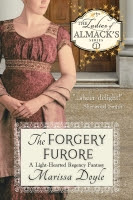We’ve talked a lot in previous posts about Queen Victoria’s children, and now her grandchildren. But it’s easy to forget that she had other close family members who weren’t descendents: the Queen actually had a half-brother and sister. They were much older than their little half-sister and did not live in England. But that doesn’t mean they didn’t play an important role in the Queen’s life…especially her sister, Feodore.
As you may recall from posts on the Great Matrimonial Race of 1818, King George III’s sons had to marry quickly in order to provide an heir to the throne. Edward, Duke of Kent, found his bride in the widowed Princess of Leiningen, Victoire. Victoire had two children from her previous marriage: a son, Charles, and a daughter—Anna Feodora Auguste Charlotte Wilhelmine, usually known as Feodore.
Feodore was born on December 7, 1807, the second child of Prince Emich Charles, at her father’s pocket-handkerchief-sized principality around the town of Amorbach, some fifty or so miles south of Frankfurt. Much older than Feodora’s mother, he died when his daughter was only seven. But in 1818, the little girl gained a new step-father, and in April 1819 was whisked away to England, where one month later her baby sister was born.
Feodore seems to have settled happily enough into her new home, learning English rapidly. A governess was found for her in the form of a Fraulein Lehzen (who is perhaps better known as her sister’s governess), and the little family settled down in Kensington Palace after the Duke of Kent’s sudden death from pneumonia only eight months after baby Victoria’s arrival. Baby Victoria was the center of the household, and Feodore adored her plump, cheerful little sister.
But as her teen years came on, she was less content with the highly circumscribed life they led: “When I look back upon those years, which ought to have been the happiest of my life, from fourteen to twenty, I cannot help pitying myself. Not to have enjoyed the pleasures of youth is nothing, but to have been deprived of all intercourse, and not one cheerful thought in that dismal existence of ours was very hard,” she wrote to Victoria decades later. Feodore would have loved to mingle in society but her mother, the Duchess of Kent, loathed King George IV and his profligate court.
The result, of course, was that Feodore rebelled. She conducted a secret flirtation with the son of one of the King’s brothers which was quickly quashed, but a bigger flirt soon occupied her attention—no less a person than the king himself, who paid the pretty nineteen-year-old a great deal of attention on a rare visit of the Kensington family to court—so much attention, in fact, that rumors started to fly that he was considering remarriage—to Feodore. The Duchess of Kent had no intention of seeing one daughter’s right to the throne endangered by her other, so Feodore was packed off to Germany to visit family. The following year, when the rumors hadn’t died away, the Duchess hastily a marriage to a man Feodore had met during her visit to Germany: Prince Ernest of Hohenlohe-Langenburg. The King was gracious enough to agree to give the bride away at their wedding in February 1828 (though in the end he sent his younger brother William to do the task).
The two sisters were desolated by their separation, and soon became faithful correspondents. Unfortunately, though Feodore became fond of her rather older husband (he was her senior by twelve years), married life was not easy. There was little money, and their home, Schloss Langenburg, was large, drafty, and very uncomfortable. Six children were eventually born to the couple; Feodore brought two of them to visit their little aunt in England in 1834. When the little aunt became Queen Victoria in the wee hours of June 20, 1837, one of her first acts that morning was to send Feodore a note assuring her of her undying affection. She also paid Feodore’s way whenever she was able to visit England.
Of Feodore’s children, her eldest son was something of a disappointment, renouncing his throne on the death of Prince Ernest in order to marry a village girl; second son Herman instead became the next Prince of Hohenlohe-Langenbach. Youngest son Victor entered the British navy and served all his life, including during the Crimean War. Feodore’s daughters were frequent visitors to England, where they spent a great deal of time with their cousins; the eldest died young but the second, Adelaide, was proposed to by the new French Emperor Napoleon III but refused him, marrying instead into another German ducal family (and eventually becoming mother-in-law to Kaiser Wilhelm II), as did her younger sister.
Feodore and Victoria remained close all their lives, corresponding frequently and visiting whenever possible. The two shared widowhood together, both losing their husbands within a year of each other; and when Feodore died in 1872, she left Victoria a farewell letter which read in part, “…I can never thank you enough for all you have done for me, for your great love and tender affection. These feelings cannot die; they must and will live on with my soul—till we meet again, never more to be separated—and you will not forget.”
Subscribe to:
Post Comments (Atom)








No comments:
Post a Comment